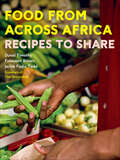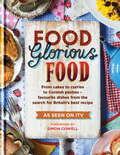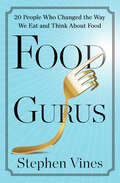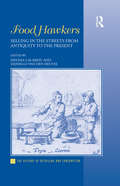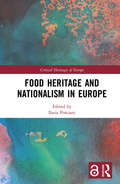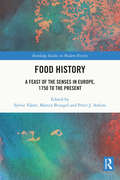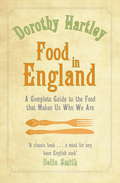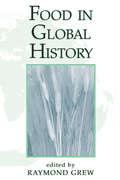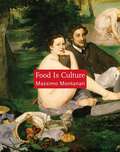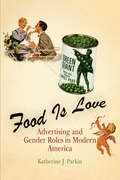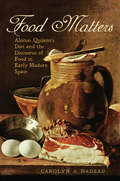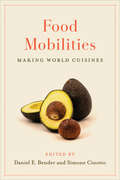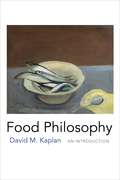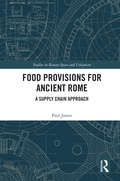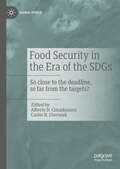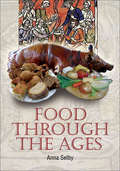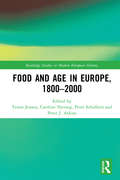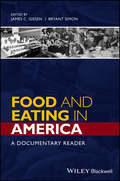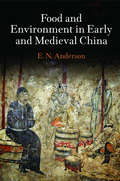- Table View
- List View
Food From Across Africa: Recipes to Share
by Duval Timothy Jacob Fodio ToddDiscover the amazing cuisine of Africa with this beautiful full-color cookbook featuring classical and modern African dishes.With its diverse, delicious flavors, African food is “some of the best on the planet,” yet remains little known to many in the wider world. To introduce this wonderful cuisine, Duval Timothy, Jacob Fodio Todd, and Folayemi Brown started their popular bi-monthly London supper club The Groundnut to showcase the food of their childhoods, dishes that reflect their heritage in Western and Eastern Africa.Based on their sold-out events, Food from Across Africa features both traditional recipes, many of which have been passed down through the generations, as well as experimental dishes using new ingredients and combinations: from the fragrant and ubiquitous West African dish, jollof rice, to innovative modern offerings like aromatic star anise and coconut chicken served in a steaming plantain leaf. Food from Across Africa includes nine complete menus with dishes that complement and enhance one another—from cocktails and juices to main courses, vegetables, sides, and desserts. Instead of making explicit distinctions, the menus represent the way these dishes fit together, whether attached by season, dominant flavors, or by another unifying point of inspiration.Easy to follow and cook, each recipe includes a short history and uses ingredients found in local markets. Pork in Tamarind, Mustard Prawns, Baked Broccoli Falafel, Pineapple Jam, Spinach & Green Bean Salad with Peanut Pesto, Banana Almond Cake, Pickled Peppers, Baked Plantain, and much more—the mouthwatering fare in Food from Across Africa is meant to be eaten communally, with family, friends, and neighbors, and enjoyed with all the senses. “Our food encourages tactility, with influences form our childhoods growing up eating freshly picked mangoes sprinkled with salty chili powder, being served juice in a peeled, cored, and squeezed orange and hand rolling and dunking balls of eba into okra soup then straight into your mouth.”A celebration of a fascinating and flavorful culture, bursting with dozens of gorgeous full-color photos, Food from Across Africa is a bounty of delights, presenting food that is simple, balanced, beautiful, and fabulous to share.
Food Glorious Food: Family Recipes for the Nation's Favourite Dishes
by Mitchell BeazleyEvery recipe tells a story. And every family has one - a recipe that tugs at your heartstrings, makes you laugh, brings back memories and sums up all that's great about food: its ability to delight our senses, bring people together and spread joy and happiness. Food, Glorious Food! - the book of the major new ITV1 series presented by Carol Vorderman - will be crammed full of these heart-warming and delicious recipes. Packed full of dishes from ordinary members of the public, the book will feature the food that we all love to cook and want to know how to cook. Those dishes will form the spine of the Food, Glorious Food! book. But each recipe will be so much more than just a list of ingredients and a set of cooking instructions: that's because each will be accompanied by the inspiring story of its creation, along with fascinating and revealing photos plucked from the personal archives of the recipe's creator and their family. The featured dishes will encompass old favourites like Lancashire Hot Pot, Cornish Pasties and Bakewell Tart, alongside new and inventive fusions of flavours that simply have to be tasted. Some dishes will incorporate quirky twists - for example, an extra ingredient that was originally added by mistake - while other recipes will stick to time-honoured techniques, handed down through multiple generations of the same family. In between the featured recipes will be thoughtful reflections on Britain's food heritage and the nation's love affair with home cooking. This is the definitive guide to the UK's best recipes, written for the people of Great Britain, by the people of Great Britain.
Food Gurus: 20 People Who Changed the Way We Eat and Think About Food
by Stephen VinesA fascinating overview of culinary history exploring the lives of twenty people who have impacted the way we dine. &“An intriguing dip into the lives and obsessions of an eclectic round up of ancient and modern food heroes whose tastes affect ours. Easy to digest, great recipes and some surprises.&” —Lindsey Bareham, The Times (London) Centuries ago, humankind thought of food as mere sustenance, but over time, it has evolved into something bigger. Now single dishes and entire cuisines can become trendy, cultural phenomena and media obsessions around the world. Why? How did we get here? Throughout history, there have been individuals who, for better or worse, have transformed how we eat and how we think about what we eat. In Food Gurus, author Stephen Vines delves into the culinary past and examines the careers and legacies of twenty of these influential people. They are chefs, writers, entrepreneurs, and other icons of the food world. Vines discusses each guru&’s personal journey, their character and passion, and the social events and history that shaped their approach to food. There are even recipes to better illustrate the type of cooking they produced—or had someone make for them. Among the gurus are the inventor of molecular gastronomy, Ferran Adria; one of Britain&’s most influential cookery writers, Isabella Beeton; the &“mother of American cooking&” and voice for sustainable agriculture, Alice Waters; and food industry innovator and entrepreneur Henry Heinz. Other featured gurus include: Robert Atkins James Beard Paul Bocuse Antonin Carême Julia Child Elizabeth David Raymond &“Ray&” Kroc Catherine de Medici Jamie Oliver Gordon Ramsay And more! Whether you enjoy history, eating, or sociology, Food Gurus has something to sate your appetite. &“[Vines&’s] choice of gurus is canny, amusing and well-researched, telling the reader not only about his heroes&’ virtues but also their clay feet.&” —Paul Levy, co-author of The Official Foodie Handbook
Food Hawkers: Selling in the Streets from Antiquity to the Present (The History of Retailing and Consumption)
by Melissa Calaresu Danielle Van HeuvelStreet vendors are ubiquitous across the world and throughout history. They are part of almost any distribution chain, and play an important role in the marketing of consumer goods particularly to poorer customers. Focusing on the food trades, this multi-disciplinary volume explores the dynamics of street selling and its impact on society. Through an investigation of food hawking, the volume both showcases the latest results from a subject that has seen the emergence of a significant body of innovative and adventurous scholarship, and advances the understanding of street vending and its impact on society by stimulating interdisciplinary and cross-disciplinary discussions. Covering a time span of approximately two millennia, from antiquity to the present, the book includes chapters on Europe and Asia, and covers a diverse range of themes such as the identity of food sellers (in terms of gender, ethnicity, and social status); the role of the street seller in the distribution of food; the marketing of food; food traders and the establishment; the representation of food hawkers; and street traders and economic development. By taking a dynamic approach, the collection has enabled its contributors to cross disciplinary boundaries and engage in discussions which extend beyond the limits of their own academic fields, and thus provide a fresh appreciation of this ancient phenomenon.
Food Heritage and Nationalism in Europe (Critical Heritages of Europe)
by Ilaria PorcianiFood Heritage and Nationalism in Europe contends that food is a fundamental element of heritage, and a particularly important one in times of crisis. Arguing that food, taste, cuisine and gastronomy are crucial markers of identity that are inherently connected to constructions of place, tradition and the past, the book demonstrates how they play a role in intangible, as well as tangible, heritage. Featuring contributions from experts working across Europe and beyond, and adopting a strong historical and transnational perspective, the book examines the various ways in which food can be understood and used as heritage. Including explorations of imperial spaces, migrations and diasporas; the role of commercialisation processes, and institutional practices within political and cultural domains, this volume considers all aspects of this complex issue. Arguing that the various European cuisines are the result of exchanges, hybridities and complex historical processes, Porciani and the chapter authors offer up a new way of deconstructing banal nationalism and of moving away from the idea of static identities. Suggesting a new and different approach to the idea of so-called national cuisines, Food Heritage and Nationalism in Europe will be a compelling read for academic audiences in museum and heritage studies, cultural and food studies, anthropology and history. Chapters 1,2,4,6 and 12 of this book are available for free in PDF format as Open Access from the individual product page at www.routledge.com. They have been made available under a Creative Commons Attribution-Non Commercial-No Derivatives 4.0 license
Food History: A Feast of the Senses in Europe, 1750 to the Present (Routledge Studies in Modern History)
by Martin Bruegel Peter J. Atkins Sylvie VabreThis pioneering book elevates the senses to a central role in the study of food history because the traditional focus upon food types, quantities, and nutritional values is incomplete without some recognition of smell, touch, sight, hearing, and taste. Eating is a sensual experience. Every day and at every meal the senses of smell, touch, sight, hearing, and taste are engaged in the acts of preparation and consumption. And yet these bodily acts are ephemeral; their imprint upon the source material of history is vestigial. Hitherto historians have shown little interest in the senses beyond taste, and this book fills that research gap. Four dimensions are treated: • Words, Symbols and Uses: Describing the Senses – an investigation of how specific vocabularies for food are developed. • Industrializing the Senses – an analysis of the fundamental change in the sensory qualities of foods under the pressure of industrialization and economic forces outside the control of the household and the artisan producer. • Nationhood and the Senses – an exploration of how the combination of the senses and food play into how nations saw themselves, and how food was a signature of how political ideologies played out in practical, everyday terms. • Food Senses and Globalization – an examination of links between food, the senses, and the idea of international significance. Putting all of the senses on the agenda of food history for the first time, this is the ideal volume for scholars of food history, food studies and food culture, as well as social and cultural historians. Putting all of the senses on the agenda of food history for the first time, this is the ideal volume for scholars of food history, food studies and food culture, as well as social and cultural historians.
Food In England: A complete guide to the food that makes us who we are
by Dorothy HartleyDorothy Hartley's FOOD IN ENGLAND became an instant classic when it was first published in 1954, and has had a deep influence on countless English cooks and food writers since.Hartley's love of the infinite variety of English cooking and her knowledge of British culture and history show why our food should never be considered dull or limited. There are unusual dishes such as the Cornish Onion and Apple Pie, and she describes some delicious puddings, cakes and breads, including an exotic violet flower ice cream, an eighteenth century coconut bread and Yorkshire teacakes.An irresistible window into centuries of culture, and illuminated with Hartley's own lively illustrations, FOOD IN ENGLAND is an unforgettable tour through culinary history and a unique insight into England's past.
Food In England: A complete guide to the food that makes us who we are
by Dorothy HartleyDorothy Hartley's FOOD IN ENGLAND became an instant classic when it was first published in 1954, and has had a deep influence on countless English cooks and food writers since.Hartley's love of the infinite variety of English cooking and her knowledge of British culture and history show why our food should never be considered dull or limited. There are unusual dishes such as the Cornish Onion and Apple Pie, and she describes some delicious puddings, cakes and breads, including an exotic violet flower ice cream, an eighteenth century coconut bread and Yorkshire teacakes.An irresistible window into centuries of culture, and illuminated with Hartley's own lively illustrations, FOOD IN ENGLAND is an unforgettable tour through culinary history and a unique insight into England's past.
Food In Global History (Global History Ser.)
by Raymond GrewExperts from a variety of disciplines place food in the framework of global history, looking at the global connections of ecology, public policy, diet, and customs on several continents.. In Food in Global History , experts on food from a variety of fields assess the relationship between global history and what people eat. Using the latest research, they address topics from public policy and international aid to cultural identity, from ecology to historical patterns of change. Individual chapters on countries in Asia, the Americas, Africa, and Europe employ contemporary data and evidence from centuries past. }Social scientists have studied foods in many different ways. Historians have most often studied the history of specific foods, and anthropologists have emphasized the role of food in religious rituals and group identities. Sociologists have looked primarily at food as an indicator of social class and a factor in social ties, and nutritionists have focused on changing patterns of consumption and applied medical knowledge to study the effects of diet on public health. Some scholars from these and other disciplines have studied the economic and political connections created around commerce in food, regionally and around the world. Now, all of these perspectives are brought together in a single volume. Fifteen specialists currently working in Canada, England, France, Guatemala, Norway, and the United States come together to apply their expert knowledge of food and food consumption in a new context, global history. In general essays and case studies, they reflect on the connections across space and time in what people eat and assess historical patterns of change in the human diet.The book begins with a consideration of the relationship between food and global history. Part One considers the global history of the ecology of food production, the contrasting impact of New World foods on India and China, the effects of global tourism, and the interaction between identity, migration, and diet. The selections in Part Two study the impact of public policy, comparing the countries of the former Soviet bloc with Scandinavia and Western Europe, analyzing the effects of international assistance on West Africa, and looking at changes in childhood nutrition in developing countries. Chapters in Part Three study nutritional change, the dietary effects of increased wealth, and the Mad Cow crisis in terms of global systems. Part Four investigates the relationship of global change to the ideologies and practices of the family meal, of food and cultural identity in Japan, and the American counterculture. }
Food In The United States, 1890-1945
by Megan J. EliasFrom the Gilded Age to the end of World War II, what, where, when, and how Americans ate all radically changed. Migration to urban areas took people away from their personal connection to food sources.
Food Is Culture
by Albert Sonnenfeld Montanari MassimoElegantly written by a distinguished culinary historian, Food Is Culture explores the innovative premise that everything having to do with food-its capture, cultivation, preparation, and consumption-represents a cultural act. Even the "choices" made by primitive hunters and gatherers were determined by a culture of economics (availability) and medicine (digestibility and nutrition) that led to the development of specific social structures and traditions. Massimo Montanari begins with the "invention" of cooking which allowed humans to transform natural, edible objects into cuisine. Cooking led to the creation of the kitchen, the adaptation of raw materials into utensils, and the birth of written and oral guidelines to formalize cooking techniques like roasting, broiling, and frying. The transmission of recipes allowed food to acquire its own language and grow into a complex cultural product shaped by climate, geography, the pursuit of pleasure, and later, the desire for health. In his history, Montanari touches on the spice trade, the first agrarian societies, Renaissance dishes that synthesized different tastes, and the analytical attitude of the Enlightenment, which insisted on the separation of flavors. Brilliantly researched and analyzed, he shows how food, once a practical necessity, evolved into an indicator of social standing and religious and political identity. Whether he is musing on the origins of the fork, the symbolic power of meat, cultural attitudes toward hot and cold foods, the connection between cuisine and class, the symbolic significance of certain foods, or the economical consequences of religious holidays, Montanari's concise yet intellectually rich reflections add another dimension to the history of human civilization. Entertaining and surprising, Food Is Culture is a fascinating look at how food is the ultimate embodiment of our continuing attempts to tame, transform, and reinterpret nature.
Food Is Culture (Arts and Traditions of the Table: Perspectives on Culinary History)
by Massimo MontanariElegantly written by a distinguished culinary historian, Food Is Culture explores the innovative premise that everything having to do with food—its capture, cultivation, preparation, and consumption—represents a cultural act. Even the "choices" made by primitive hunters and gatherers were determined by a culture of economics (availability) and medicine (digestibility and nutrition) that led to the development of specific social structures and traditions.Massimo Montanari begins with the "invention" of cooking which allowed humans to transform natural, edible objects into cuisine. Cooking led to the creation of the kitchen, the adaptation of raw materials into utensils, and the birth of written and oral guidelines to formalize cooking techniques like roasting, broiling, and frying. The transmission of recipes allowed food to acquire its own language and grow into a complex cultural product shaped by climate, geography, the pursuit of pleasure, and later, the desire for health. In his history, Montanari touches on the spice trade, the first agrarian societies, Renaissance dishes that synthesized different tastes, and the analytical attitude of the Enlightenment, which insisted on the separation of flavors. Brilliantly researched and analyzed, he shows how food, once a practical necessity, evolved into an indicator of social standing and religious and political identity. Whether he is musing on the origins of the fork, the symbolic power of meat, cultural attitudes toward hot and cold foods, the connection between cuisine and class, the symbolic significance of certain foods, or the economical consequences of religious holidays, Montanari's concise yet intellectually rich reflections add another dimension to the history of human civilization. Entertaining and surprising, Food Is Culture is a fascinating look at how food is the ultimate embodiment of our continuing attempts to tame, transform, and reinterpret nature.
Food Is Love
by Katherine J. ParkinModern advertising has changed dramatically since the early twentieth century, but when it comes to food, Katherine Parkin writes, the message has remained consistent. Advertisers have historically promoted food in distinctly gendered terms, returning repeatedly to themes that associated shopping and cooking with women. Foremost among them was that, regardless of the actual work involved, women should serve food to demonstrate love for their families. In identifying shopping and cooking as an expression of love, ads helped to both establish and reinforce the belief that kitchen work was women's work, even as women's participation in the labor force dramatically increased. Alternately flattering her skills as a homemaker and preying on her insecurities, advertisers suggested that using their products would give a woman irresistible sexual allure, a happy marriage, and healthy children. Ads also promised that by buying and making the right foods, a woman could help her family achieve social status, maintain its racial or ethnic identity, and assimilate into the American mainstream.Advertisers clung tenaciously to this paradigm throughout great upheavals in the patterns of American work, diet, and gender roles. To discover why, Food Is Love draws on thousands of ads that appeared in the most popular magazines of the twentieth and early twenty-first centuries, including the Ladies' Home Journal, Good Housekeeping, Ebony, and the Saturday Evening Post. The book also cites the records of one of the nation's preeminent advertising firms, as well as the motivational research advertisers utilized to reach their customers.
Food Matters: Alonso Quijano's Diet and the Discourse of Food in Early Modern Spain
by Carolyn A. NadeauIn the second sentence of Don Quixote, Cervantes describes the diet of the protagonist, Alonso Quijano: "A stew made of more beef than mutton, cold salad on most nights, abstinence eggs on Saturdays, lentils on Fridays, and an additional squab on Sundays."Through an inventive and original engagement with this text, Carolyn A. Nadeau explores the shifts in Spain's cultural and gastronomic history. Using cooking manuals, novels, poems, dietary treatises, and other texts, she brings to light the figurative significance of foodstuffs and culinary practices in early modern Spain. Drawing on the work of Pierre Bourdieu and Stephen Mennell, Food Matters reveals patterns of interdependence as observed, for example, in how Muslim and Jewish aversion to pork fired Spain's passion for ham, what happened when New World foodstuffs entered into Old World kitchens, and how food and sexual urges that so often came together, regardless of class, ethnicity, or gender, construct moments of communal celebration.This mouth-watering tour of the discourses of food in early modern Spain is complemented by an appendix that features forty-seven recipes drawn from contemporary sources.
Food Mobilities: Making World Cuisines (Culinaria #1)
by Simone Cinotto Daniel E. BenderBringing together multidisciplinary scholars from the growing discipline of food studies, Food Mobilities examines food provisioning and the food cultures of the world, historically and in contemporary times. The collection offers a range of fascinating case studies, including explorations of Italian food in colonial Ethiopia, traditional Cornish pasties in Mexico, migrant community gardeners in Toronto, and beer all around the world. In exploring the origins of the contemporary global food system and how we cook and eat today, Food Mobilities uncovers the local and global circulation of food, ingredients, cooks, commodities, labour, and knowledge.
Food Nations: Selling Taste in Consumer Societies (Hagley Perspectives on Business and Culture)
by Warren Belasco Philip ScrantonThis original collection abandons culinary nostalgia and the cataloguing of regional cuisines to examine the role of food and food marketing in constructing culture, consumer behavior, and national identity.
Food Philosophy: An Introduction (California Studies In Food And Culture Ser. #39)
by David M. KaplanFood is a challenging subject. There is little consensus about how and what we should produce and consume. It is not even clear what food is or whether people have similar experiences of it. On one hand, food is recognized as a basic need, if not a basic right. On the other hand, it is hard to generalize about it given the wide range of practices and cuisines, and the even wider range of tastes.This book is an introduction to the philosophical dimensions of food. David M. Kaplan examines the nature and meaning of food, how we experience it, the social role it plays, its moral and political dimensions, and how we judge it to be delicious or awful. He shows how the different branches of philosophy contribute to a broader understanding of food: what food is (metaphysics), how we experience food (epistemology), what taste in food is (aesthetics), how we should make and eat food (ethics), how governments should regulate food (political philosophy), and why food matters to us (existentialism). Kaplan embarks on a series of philosophical investigations, considering topics such as culinary identity and authenticity, tasting and food criticism, appetite and disgust, meat eating and techno-foods, and consumerism and conformity. He emphasizes how different narratives help us navigate the complex world of food and reminds us we all have responsibilities to ourselves, to others, and to animals. An original treatment of a timely subject, Food Philosophy is suitable for undergraduates while making a significant contribution to scholarly debates.
Food Provisions for Ancient Rome: A Supply Chain Approach (Studies in Roman Space and Urbanism)
by Paul JamesThis book defines the processes used for delivering a range of food items to the city of Rome and its hinterland from the first century AD using modern supply chain modelling techniques. The subject matter delves into the wider supply of goods, such as wood and building products, to add further perspective to the breadth of the system managed by the Roman administration to ensure supply and political stability. It assesses the impact of strategic changes such as the introduction of water-powered milling technology and restructuring of the annona in this period, as well as administrative reforms. Evidence from ancient sources, both literary and epigraphic, along with relevant archaeological comparative evidence is used to develop a detailed supply model, including the mapping of warehouse management systems; port and river traffic co-ordination; quality control mechanisms and administrative structures. Unlike other contemporary studies, this model takes into consideration supply chain losses to correct the erroneous assumption that supply is equal to consumption. A product flow map from the source of supply to the consumer details the labour, equipment and infrastructure required at each stage, painting a graphic picture of just what an achievement it was for the administration to have maintained such a complex system over this long time period. Food Provisions for Ancient Rome provides an in depth exploration of this topic that will be of interest to anyone working on the city of Rome under the empire, as well as those interested in imperial administration and logistics.
Food Security in the Era of the SDGs: So close to the deadline, so far from the targets? (Global Ethics)
by Alberto D. Cimadamore Carlos B. CherniakThis book addresses the challenges to achieve food security, which can arguably be one of the axis of any transformational solution to the structural production and reproduction of hunger, malnutrition, and poverty. According to the picture depicted in the book, access to sufficient and safe food is not guaranteed for approximately 2.4 billion people, with women and children in rural areas being the most significantly affected. Particularly, the situation concerning children has set off all the alarms. Based on the data offered in the different chapters, the authors estimate that would be very difficult -if not impossible- to achieve the most important global objectives that the international community has committed to achieving by 2030: ending poverty, hunger, and food insecurity. This way, the most ambitious and well-intended development initiative the international community was able to put together in the history of humankind (the Agenda 2030) is derailing. Urgent expansion in the supply of the nutritious foods that constitute a healthy diet and a shift in consumption patterns are required -among other things- to effectively address SDGs targets. The book presents and discusses contributions of authors who have been thinking and facing those challenges in the academia and decision-making spheres. It is also a relevant contribution to rethinking the public policies of Latin American and Caribbean (LAC) countries, as well as the technical cooperation and financial assistance schemes for the region. The rethinking exercise sketched here places LAC both as a critical scenario and as a laboratory for envisioning innovative solutions that have the potential to not only transform the regional reality but also to be replicated in other regions with the proper adaptation to different contexts.
Food Through the Ages: From Stuffed Dormice to Pineapple Hedgehogs
by Anna SelbyThe author of Victorian Christmas “recounts some of the most fascinating—and disgusting—dishes our ancestors used to eat. . . . A must-buy book for foodies” (Fiona Shoop, author of How to Deal in Antiques). With people’s fascination for food increasing, there are more cooking shows and magazines than ever. Medieval banquets are sold-out events and classic recipes and ingredients are back in fashion, which is what this book sets out to explore. Highlighting the advantages and disadvantages of each era from Roman times onwards, Anna Selby recreates classic recipes from Epicurius’s stuffed dormice to recipes that readers really will want to recreate. She explores how trade and improved transportation increased foodstuffs available and reflects on how we’re returning to the old-fashioned notion of seasonal foods—just like our ancestors had to do.
Food Waste and Sustainable Food Waste Management in the Baltic Sea Region
by Walter Leal Filho Marina KovalevaThis work presents the findings of an extensive study on the state-of-the-art regarding the problem of food waste in Belarus, Estonia, Germany, Latvia, Lithuania, Poland and Sweden. The results show that the problem of food waste can be found at different levels in each country and that our knowledge of it is limited by the current lack of studies in the area. The problem is primarily due to food waste generated by the manufacturing sector, mostly in the form of unused or inefficiently used by-products, as well as on a share of food thrown away by households that is still suitable for human consumption. The main reduction/prevention method, applied across the countries, is food donation; the remaining methods are the same ones used for biodegradable waste in the respective countries. The findings gathered in this study show a number of potential measures/methods for sustainable food waste management, which may be considered in future works in order to reduce the amounts of food waste generated in each of the aforementioned countries.
Food and Age in Europe, 1800-2000 (Routledge Studies in Modern European History)
by Tenna Jensen Caroline Nyvang Peter Scholliers Peter J. AtkinsPeople eat and drink very differently throughout their life. Each stage has diets with specific ingredients, preparations, palates, meanings and settings. Moreover, physicians, authorities and general observers have particular views on what and how to eat according to age. All this has changed frequently during the previous two centuries. Infant feeding has for a long time attracted historical attention, but interest in the diets of youngsters, adults of various ages, and elderly people seems to have dissolved into more general food historiography. This volume puts age on the agenda of food history by focusing on the very diverse diets throughout the lifecycle.
Food and Eating in America: A Documentary Reader (Uncovering the Past: Documentary Readers in American History)
by Bryant Simon James C. GiesenGuides students through a rich menu of American history through food and eating This book features a wide and diverse range of primary sources covering the cultivation, preparation, marketing, and consumption of food from the time before Europeans arrived in North America to the present-day United States. It is organized around what the authors label the “Four P’s”—production, politics, price, and preference—in order to show readers that food represents something more than nutrition and the daily meals that keep us alive. The documents in this book demonstrate that food we eat is a “highly condensed social fact” that both reflects and is shaped by politics, economics, culture, religion, region, race, class, and gender. Food and Eating in America covers more than 500 years of American food and eating history with sections on: An Appetizer: What Food and Eating Tell Us About America; Hunting, Harvesting, Starving, and the Occasional Feast: Food in Early America; Fields and Foods in the Nineteenth Century; Feeding a Modern World: Revolutions in Farming, Food, and Famine; and Counterculture Cuisines and Culinary Tourism. Presents primary sources from a wide variety of perspectives—Native Americans, explorers, public officials, generals, soldiers, slaves, slaveholders, clergy, businessmen, workers, immigrants, activists, African Americans, Hispanics, Asian Americans, artists, writers, investigative reporters, judges, the owners of food trucks, and prison inmates Illustrates the importance of eating and food through speeches, letters, diaries, memoirs, newspaper and magazine articles, illustrations, photographs, song lyrics, advertisements, legislative statutes, court rulings, interviews, manifestoes, government reports, and recipes Offers a new way of exploring how people lived in the past by looking closely and imaginatively at food Food and Eating in America: A Documentary Reader is an ideal book for students of United States history, food, and the social sciences. It will also appeal to foodies and those with a curiosity for documentary-style books of all kinds.
Food and Emotions in Italian Women's Writing: A Reassessment (Toronto Italian Studies)
by Patrizia SambucoFood and Emotions in Italian Women’s Writing discusses the relevance of food imagery in the writing of Italian women over a period of one hundred years, from the 1920s to the present day, while offering new ways to narrate women’s history and creativity. In this groundbreaking work, Patrizia Sambuco shows how food imagery in different historical periods challenge established political discourses by conveying unexpressed, alternative, or transgressive emotions. Through literary analysis, archival research, and philosophical approaches to the senses, emotions, and food, the book considers a variety of authors, from the celebrated to the hardly known. Sambuco argues that in different ways, throughout the decades, the conceptual domain of food has helped express forms of selfhood that push the boundaries of womanhood and interact with cultural and political panoramas at national and international levels. Building an alternative history of Italian women and their creativity, Sambuco shows how the interplay of the senses and emotions becomes a profitable way to illuminate overlooked aspects of women’s subjectivity. Food and Emotions in Italian Women's Writing ultimately reassesses women’s writing, giving value to the marginality of women’s bodies and positions through the conceptual domain of food.
Food and Environment in Early and Medieval China (Encounters with Asia)
by E. N. AndersonChinese food is one of the most recognizable and widely consumed cuisines in the world. Almost no town on earth is without a Chinese restaurant of some kind, and Chinese canned, frozen, and preserved foods are available in shops from Nairobi to Quito. But the particulars of Chinese cuisine vary widely from place to place as its major ingredients and techniques have been adapted to local agriculture and taste profiles. To trace the roots of Chinese foodways, one must look back to traditional food systems before the early days of globalization.Food and Environment in Early and Medieval China traces the development of the food systems that coincided with China's emergence as an empire. Before extensive trade and cultural exchange with Europe was established, Chinese farmers and agriculturalists developed systems that used resources in sustainable and efficient ways, permitting intensive and productive techniques to survive over millennia. Fields, gardens, semiwild lands, managed forests, and specialized agricultural landscapes all became part of an integrated network that produced maximum nutrients with minimal input—though not without some environmental cost. E. N. Anderson examines premodern China's vast, active network of trade and contact, such as the routes from Central Asia to Eurasia and the slow introduction of Western foods and medicines under the Mongol Empire. Bringing together a number of new findings from archaeology, history, and field studies of environmental management, Food and Environment in Early and Medieval China provides an updated picture of language relationships, cultural innovations, and intercultural exchanges.
